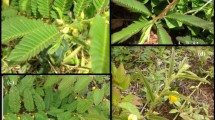Abstract
Piper nigrum L. (family: Piperaceae) is cultivated for its mature fruit/berries. Generally dried, they are one of the most important commercial spice/food additives. The dried fruit of P. nigrum is almost similar in morphology to seeds of Carica papaya L. and is used as an adulterant of P. nigrum. Molecular technology and plant metabolomics are effective tools for unequivocal authentication and detection of food ingredients. In this study, DNA fingerprinting-based quality control markers [sequence characterized amplified region (SCAR) markers] were employed for authentication and discrimination of P. nigrum from its adulterant C. papaya. The 500- and 750-bp-sized SCAR markers of P. nigrum and C. papaya were amplified using their specific SCAR primer sets. Further, metabolic profiling was carried out using gas chromatography–mass spectrometry (GC-MS) on the fruits and seeds of P. nigrum and C. papaya, respectively. For P. nigrum and for C. papaya, 84 and 61 chemically diverse metabolites were observed, respectively, among which 44 and 33 metabolites were putatively selected, respectively. The detection efficiency of GC-MS was assessed by combining the powdered samples of both P. nigrum and C. papaya in different ratios and was able to detect as low as 20 mg/g (w/w) (20,000 ppm) of metabolites. Multivariate data analysis and clustering analysis was performed on the mixture samples of both the food ingredients. Thus, development of SCAR markers along with the phytochemical fingerprints can correlate DNA fingerprinting data with the quantity of active ingredient and/or phytochemical constituents associated with the specific spice/herb/(s).









Similar content being viewed by others
References
Adinolfi B, Chicca A, Martinotti E, Breschi MC, Nieri P (2007) Sequence characterized amplified region (SCAR) analysis on DNA from three medicinal Echinacea species. Fitoterapia 78:43–45
Atal CK, Manavalan R, Nighojkar R, Sareen AN, Gupta OP (1980) Studies on Piper chaba as a bioavailable agent. Indian Drugs 17:266–268
Banerjee P, Ghosh S, Dutta M, Subramani E, Khalpada J et al (2013) Identification of key contributory factors responsible for vascular dysfunction in idiopathic recurrent spontaneous miscarriage. PLoS One 8(11):e80940
Bano G, Amla V, Raina RK, Zutshi U, Chopra CL (1987) The effect of piperine on pharmacokinetics of phenytoin in healthy volunteers. Planta Med 53:568–569
Bhatia A, Bharti SK, Tewari SK, Sidhu OP, Roy R (2013) Metabolic profiling for studying chemotype variations in Withania somnifera (L.) dunal fruits using GC–MS and NMR spectroscopy. Phytochemistry 93:105–115
Choi KT (2008) Botanical characteristics, pharmacological effects and medicinal components of Korean Panax Ginseng C A Meyer. Acta Pharmacol Sin 29:1109–1118
De Vos RCH, Moco S, Lommen A, Keurentjes JJB, Bino RJ, Hall RD (2007) Untargeted large-scale plant metabolomics using liquid chromatography coupled to mass spectrometry. Nat Protoc 2:778–791
Devaiah K, Balasubramani SP, Venkatasubramanian P (2011) Development of randomly amplified polymorphic DNA based SCAR marker for identification of Ipomoea mauritiana Jacq (Convolvulaceae). Evid Based Complementary Altern Med. https://doi.org/10.1093/ecam/neq023
Dhanya K, Syamkumar S, Sasikumar B (2009) Development and application of SCAR marker for the detection of papaya seed adulteration in traded black pepper powder. Food Biotechnol 23:97–106
Dnyaneshwar W, Preeti C, Kalpana J, Bhushan P (2006) Development and application of RAPD-SCAR marker for identification of Phyllanthus emblica Linn. Biol Pharm Bull 29:2313–2316
Fiehn O, Kopka J, Dormann P, Altmann T, Trethewey RN, Willmitzer L (2000) Metabolite profiling for plant functional genomics. Nature Biotechnol 18:1157–1161
Ganie SH, Srivastava PS, Narula A, Ali Z, Sharma MP (2012) Authentication of shankhpushpi by RAPD. Eurasia J Biosci 6:39–46
Gika HG, Theodoridis GA, Wingate JE, Wilson ID (2007) Within-day reproducibility of an HPLC–MS-based method for metabonomic analysis: application to human urine. J Proteome Res 6:3291–3303
Hu RQ, Davies JA (1997) Effects of Piper nigrum L. on epileptiform activity in cortical wedges prepared from DBA/2 mice. Phytother Res 11:222–225
Jung BS, Shin MK (1998) Encyclopedia of illustrated Korean natural drugs, Araliaceae. In: Kwon, S.B. (Ed.), Young Lim Sa, Seoul, pp. 439–443
Kasai K, Morikawa Y, Sorri VA, Valkonen JPT, Gebhardt C, Watanabe KN (2000) Development of SCAR markers to the PVY resistance gene Ryadg based on a common feature of plant disease resistance genes. Genome 43:1–8
Kathidi DR, Roden DB, Ladd TR, Krell PJ, Retnakaran A, Feng Q (2003) Development of SCAR markers for the DNA-based detection of the Asian long-horned beetle; Anoplophora ghbripennis (Motschulsky). Arc Insect Biochem Physiol 52:193–204
Kende A, Portwood D, Senior A, Earll M, Bolygo E, Seymour M (2010) Target list building for volatile metabolite profiling of fruit. J Chromatogr A 1217:6718–6723
Khan S, Qureshi MI, Kamaluddin AT, Abdin MZ (2007) Protocol for isolation of genomic DNA from dry and fresh roots of medicinal plants suitable for RAPD and restriction digestion. African J Biotechnol 6:175–178
Kiran U, Khan S, Mirza KJ, Ram M, Abdin MZ (2010) SCAR markers: a potential tool for authentication of herbal drugs. Fitoterapia 81:969–976
Lee MY, Doh EJ, Park CH, Kim YH, Kim ES, Ko BS, Oh SE (2006) Development of SCAR marker for discrimination of Artemisia princeps and A. argyi from other Artemisia herbs. Biol. Pharm. Bull 29:629–633
Lee DK, Yoon MH, Kang YP, Yu J, Park JH, Lee J, Kwon SW (2013) Comparison of primary and secondary metabolites for suitability to discriminate the origins of Schisandra chinensis by GC/MS and LC/MS. Food Chem 141:3931–3937
Lindon JC, Holmes E, Nicholson JK (2007) Metabonomics in pharmaceutical R&D. FEBS J 274:1140–1151
Lohiya NK, Manivannan B, Mishra PK, Pathak N, Sriram S, Bhande SS, Panneerdoss S (2002) Chloroform extract of Carica Papaya seeds induces long-term reversible azoospermia in langur monkey. Asian J Androl 4:17–26
Lohiya NK, Mishra PK, Pathak N, Manivannan B, Jain SC (1999) Reversible azoospermia by oral administration of the benzene chromatographic fraction of the chloroform extract of the seeds of Carica papaya in rabbits. Adv Contracept 15:141–161
Marieschi M, Torelli A, Bruni R (2012) Quality control of saffron (Crocus sativus). Development of SCAR markers for the detection of plant adulterants used as bulking agents. J Agri Food Chem 60:10998–11004
Moco S, Bino RJ, Vorst O, Verhoeven HA, de Groot J, van Beek TA et al (2006) A liquid chromatography–mass spectrometry-based metabolome database for tomato. Plant Physiol 141:1205–1218
Nadkarni AK, Nadkarni KM (1954) Indian Materia Medica, vol 2. Popular Book Depot, Bombay
Paran I, Michelmore RW (1993) Development of reliable PCR-based markers linked to downy mildew resistance genes in lettuce. Theor Appl Genet 85:985–993
Pathak N, Mishra PK, Manivannan B, Lohiya NK (2000) Sterility due to inhibition of sperm motility by oral administration of benzene chromatographic fraction of the chloroform extract of the seeds of Carica papaya in rats. Phytomedicine 7:325–333
Patwardhan B, Warude D, Pushpangadan P, Bhatt N (2005) Ayurveda and traditional Chinese medicine: a comparative overview. J Evid Based Complementary Altern Med 2:465–473
Saad B, Azaizeh H, Abu-Hijleh G, Said O (2006) Safety of traditional Arab herbal medicine. Evid Based Complementary Altern Med 3:433–439
Schauer N, Fernie AR (2006) Plant metabolomics: towards biological function and mechanism. Trends Plant Sci 11:508–516
Seethapathy GS, Balasubramani SP, Venkatasubramanian P (2014) nrDNA ITS sequence based SCAR marker to authenticate Aconitum heterophyllum and Cyperus rotundus in Ayurvedic raw drug source and prepared herbal products. Food Chem 145:1015–1020
Shinde M, Dhalwal K, Mahadik KR, Joshi KS, Patwardhan BK (2007) RAPD analysis for determination of components in herbal medicine. Evi based Compl Alt Med 4:21–23. https://doi.org/10.1093/ecam/nem109
Theerakulpisut P, Kanawapee N, Maensiri D, Bunnag S, Chantaranothai P (2008) Development of species-specific SCAR markers for identification of three medicinal species of Phyllanthus. J Syst Evol 46:614–621
Ulrich-Merzenich G, Zeitler H, Jobst D, Panek D, Vetter H, Wagner H (2007) Application of the “-Omic-” technologies in phytomedicine. Phytomedicine 14:70–82
Villegas VN (1997) Edible fruits and nuts—Carica papaya L. In EWM Verheij, RE Coronel, eds, Vol 2. Wageningen University, Netherlands
von Roepenack-Lahaye E, Degenkolb T, Zerjeski M, Franz M, Roth U, Wessjohann L et al (2004) Profiling of Arabidopsis secondary metabolites by capillary liquid chromatography coupled to electrospray ionization quadrupole time-of-flight mass spectrometry. Plant Physiol 134:548–559
Williams JG, Kubelik AR, Livak KJ, Rafalski JA, Tingey SV (1990) DNA polymorphisms amplified by arbitrary primers are useful as genetic markers. Nucleic Acids Res 18:6531–6535
Zutshi RK, Singh R, Zutshi U, Johri RK, Atal CK (1985) Influence of piperine on rifampicin blood levels in patients of pulmonary tuberculosis. J Assoc Physicians India 33:223–224
Acknowledgments
The infrastructure created from UGC-SAP grant to the Department Of Biotechnology is thankfully acknowledged.
Author information
Authors and Affiliations
Corresponding author
Ethics declarations
This study was funded by University grants commission, India (7–357/ BSR).
Conflict of Interest
Irum Gul declares that she has no conflict of interest. Nazima Nasrullah declares that she has no conflict of interest. Umara Nissar declares that she has no conflict of interest. Monica Saifi declares that she has no conflict of interest. Malik Z Abdin declares that he has no conflict of interest.
Ethical Approval
This article does not contain any studies with human participants or animals performed by any of the authors.
Informed Consent
Informed consent for this study is not applicable.
Electronic supplementary material
ESM 1
(DOCX 16 kb)
Rights and permissions
About this article
Cite this article
Gul, I., Nasrullah, N., Nissar, U. et al. Development of DNA and GC-MS Fingerprints for Authentication and Quality Control of Piper nigrum L. and Its Adulterant Carica papaya L.. Food Anal. Methods 11, 1209–1222 (2018). https://doi.org/10.1007/s12161-017-1088-7
Received:
Accepted:
Published:
Issue Date:
DOI: https://doi.org/10.1007/s12161-017-1088-7




